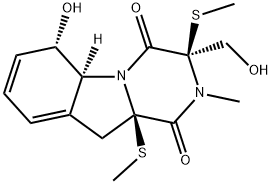
BIS(METHYLTHIO)GLIOTOXIN
- Product NameBIS(METHYLTHIO)GLIOTOXIN
- CAS74149-38-5
- CBNumberCB1288191
- MFC15H20N2O4S2
- MW356.46
- MDL NumberMFCD00133146
- MOL File74149-38-5.mol
- MSDS FileSDS
Chemical Properties
| Boiling point | 669.6±55.0 °C(Predicted) |
| Density | 1.49±0.1 g/cm3(Predicted) |
| storage temp. | −20°C |
| solubility | Chloroform (Slightly), Methanol (Slightly) |
| form | White solid. |
| pka | 12.69±0.60(Predicted) |
| color | Off-White to Yellow |
| biological source | natural |
| Water Solubility | water: soluble |
| UNSPSC Code | 12352205 |
| NACRES | NA.25 |
Safety
| Symbol(GHS) |

|
|||||||||
| Signal word | Warning | |||||||||
| Hazard statements | H302+H312+H332 | |||||||||
| Precautionary statements | P261-P264b-P270-P271-P280-P302+P352-P304+P340-P312-P330-P363-P403-P501c | |||||||||
| Hazard Codes | Xn | |||||||||
| Risk Statements | 20/21/22 | |||||||||
| Safety Statements | 36 | |||||||||
| RIDADR | 1544 | |||||||||
| HazardClass | 6.1(b) | |||||||||
| PackingGroup | III | |||||||||
| NFPA 704: |
|